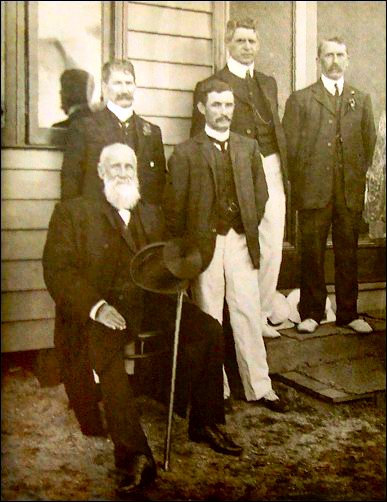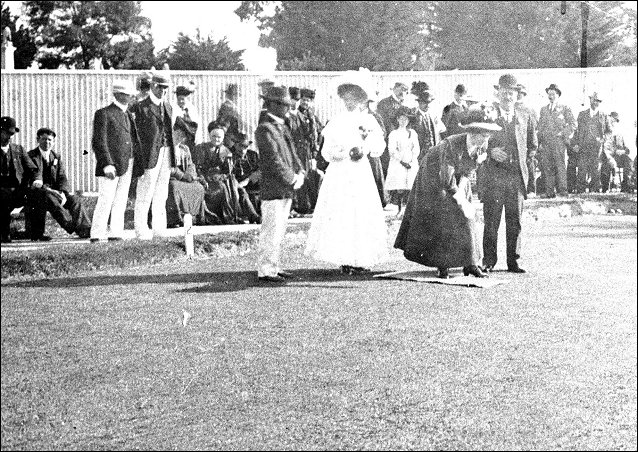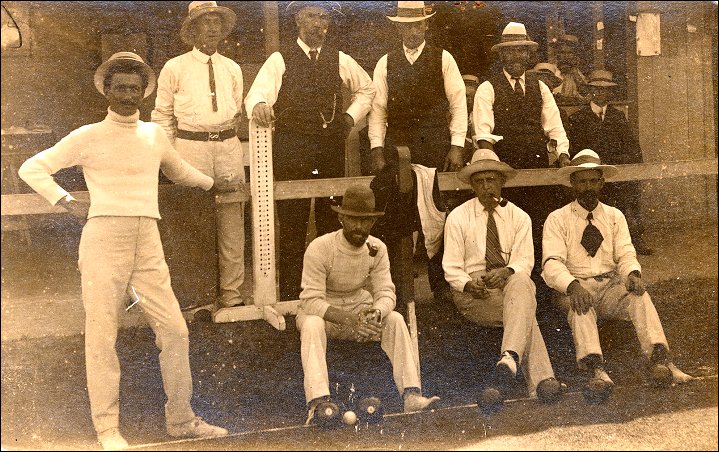Cheltenham Bowling Club: Finding a Site

The Faithful Five of the Cheltenham Bowling Club, 1908. Front: H Comport, W Fairlam. Back: J Keys, R McFarlane and J Wedd. Courtesy Cheltenham Bowling Club.
All those interested in forming a bowling club at Cheltenham were invited to attend a public meeting on September 23, 1907. The meeting, organised by W P Fairlam, J Wedd, and R McFarlane, was held in the Cheltenham Mechanics’ Hall. But some time was to pass before the first bowl was delivered on the green.
A similar meeting was held earlier at the Mentone Hotel on November 27, 1902 to herald the coming of the Moorabbin Bowls Club where many Cheltenham residents became members. This club was located on the corner of Swanston and Balcombe roads Mentone. [2] Despite the existence of this club several Cheltenham residents felt it was time that Cheltenham, a township in its own right and one with a longer history than Mentone, should have a club of its own. The initial problems faced by the initiators of the Cheltenham proposal were finding sufficient members to form a club and achieving agreement on an appropriate site. [3]
About twenty five men attended the Cheltenham meeting, chaired by Cr Francis Le Page, but clearly some initial planning had been done at meetings of a smaller group. Northcott, writing in 1996, indicated there exists some confusion about these earlier meetings and the genesis of the club. He noted two separate meetings, one at the Exchange Hotel and another at the home of Henry Comport. [4] Nevertheless, it was at the meeting at the Mechanics’ Hall that Cr Brownfield moved and Mr Scullin seconded the motion, “That this meeting considers it an opportune time to form a bowling club at Cheltenham”. The motion was passed unanimously. [5]
Once the meeting decided that a bowls club should be formed the discussion moved to consider its location. Three possible sites were explored. One was in the Cheltenham Reserve. Some years earlier a section on the south west corner of the Cheltenham Reserve was earmarked as a possible site for a bowls club. A second suggestion was on land owned by William Fairlam behind the shops in Charman Road and adjacent to the existing cricket pitch. While a third site, behind the railway station, was mentioned it received no vocal support at the meeting.
Mr Fairlam explained the benefits and deficiencies of the three sites to the meeting. The Cheltenham Reserve was available without cost, was 150 ft by 190 ft, and fenced on two sides with ti-tree hedges. Excellent filling was available and there was a water main only 140 ft away. This was also the location of the local cricket and football clubs so there would be the added benefit of concentrating several sporting clubs on the one reserve. The land at the rear of the Cheltenham station was available by application to the Shire Council but he believed the site had several drawbacks. A lot of the earth would have to be removed, an expensive operation, and in addition they would need permission from the Railway Department to lay on water and provide for drainage. This would cost money. The third option, his own paddock, was 130ft by 150 ft of level land requiring minimal work to make it ready for the bowls season. While he acknowledged members would have to pay for this land he was prepared to make it available on easy terms of £50 repaid over three or five years or £25 for cash. Fairlam recommended to the meeting that the Cheltenham Reserve option be adopted. [6]
Following Fairlam’s presentation several men gave their views. Henry Comport, a long term resident of Cheltenham, condemned the site behind the station because of the amount of work required to make it suitable and believed the drainage would be expensive. He acknowledged the Cheltenham Reserve as a suitable place but believed the Fairlam ground was the best because of its central location and the ease in which it would be drained. Mr Wedd supported the Comport view suggesting it would cost £25 to put the Cheltenham Reserve into an appropriate state. Mr Tyler then moved and Mr Comport seconded a motion that the Fairlam land be selected.
Cr Brownfield spoke strongly in favour of the recreation ground arguing that it could be made into a first class green for £30 in contrast to the £50 purchase price of the Fairlam paddock as they did not have the money to take advantage of the £25 cash offer. Moreover, he stressed, the recreation ground had been given to the community by the government and was managed by elected trustees, so in his view they should support it. Cr Le Page and other people present at the meeting agreed with Cr Brownfield and when the Tyler motion regarding the Fairlam land was put to the meeting it was lost. After further discussion it was decided to inspect the various sites and adjourn the meeting to the following week. [7]
Cr Le Page in opening the reconvened meeting expressed the hope that a unanimous decision would be reached about the location of the new club. Unfortunately this was not to be. There were still two groups of people who maintained their previous positions. Once again Tyler moved that the Fairlam land be the site of the new venture and was supported in this move by Henry Comport. Dr Weigall strengthened the Fairlam proposal by offering to buy the land and letting the club have the use of it for five years after which time the club could pay him what he paid for the land. The only condition he stipulated was that he should be made an honorary member of the club. While some individuals saw Dr Weigall’s offer as a generous one, even though he was getting 8 per cent on his investment, they still maintained the Cheltenham Recreation Reserve was the better option. Cr Penny pointed out, that if people were concerned about the cost of water for the Recreation Reserve site a windmill could be erected and water obtained for nothing. After lengthy discussion the motion to establish a bowling club on the Fairlam land was put to the meeting and passed on a majority of two votes. [8]
Having agreed to call the club the Cheltenham Bowling Club the meeting proceeded to elect office bearers and to fix the annual subscription. Neither issue was easily resolved. There was a reluctance of those present to accept nomination to leadership positions in the club. The Moorabbin News report said it was a tedious task with the position of president, normally a coveted position, going begging until finally W Fairlam was appointed. Dr Weigall and Mr Woff were selected as vice presidents with Mr McFarlane and Mr Tyler taking the positions of secretary and treasurer respectively. J Keys, Pentland, Brownfield and Holyoak agreed to become committee members.
Many people present at the meeting feared that a high subscription would deter some individuals from joining but the club needed money to establish itself. The purchase of the land, the laying of the greens and other works were estimated to cost about £100 so to reach this amount a subscription of £2 2s was seen to be necessary. This was a prohibitive sum for some people. Finally it was resolved to have a joining fee of £1 1s but a subscription of £1 1s. [9]
The difference of views about the site of the greens was seen to be divisive for the club’s future so a third meeting was called in an effort to gain unanimity. Chaired by W Fairlam the well attended meeting once again canvassed options despite the earlier small majority decision in favour of the Fairlam land. Dr Scantlebury gave his support to the recreation ground and was joined by his medical colleague Dr Weigall who had previously argued for the Fairlam land. Both recognized the need for agreement on the site for without it they were unlikely to gain the number of members necessary to meet costs. Mr Woff also changed his view to give support to the recreation ground option but others demonstrated no such flexibility. Henry Comport persisted in his support for the Fairlam option arguing that “any old woman would know that the ground was the best.” Despite Comport’s view, supported by others, a motion was put to the meeting to rescind the previous Fairlam decision and make a fresh start. This was carried unanimously and the meeting was deferred once again to a later date. [10]
At the next meeting a unanimous decision was made to locate the green on land behind the Cheltenham Railway Station, a location that received little if any support in earlier discussions. (The basis for this change of view has not been identified but it may have been a compromise to draw together the rival groups supporting the Cheltenham Reserve and the Fairlam land options, or it may have been because of the site’s close proximity to the railway station.) The club secretary, McFarlane, wrote to the Shire Council seeking the right of occupancy of about one acre of the park for bowling green purposes. He also attended the meeting of Council to support the application. McFarlane acknowledged there had been difficulty in selecting a site but that problem had been resolved and thirty gentlemen had indicated their intention to become members.

The Cheltenham Bowling Club in the Cheltenham Park behind the railway station, 1909. Courtesy Betty Kuc.
Mr McFarlane experienced some antagonism from several councillors regarding the application. Cr Scudds from Mentone, the president of the Moorabbin Bowling Club, believed further information was needed and wondered why the recreation ground was not to be used given its close proximity to the ground now asked for. Cheltenham people should be consulted, he said, as to whether that portion of the public park should be excised or not. He moved that the matter be held over for two weeks until additional information was provided. Cr Ferdinando agreed with Scudds noting that the delay would not affect the new club because the bowling season had already commenced. Cr Brownfield said he would vote against the ground being granted. In his view the recreation ground was the better site. [11]
Other councillors supported the club’s application. Le Page saw the requested ground as a most suitable one because it was close to the station and ‘prettily situated’. Cr Mills of Heatherton agreed, noting its drainage was perfect and with the addition of a topsoil dressing would make a splendid green. Cr Barnett also greeted the proposal enthusiastically believing the bowling green would improve the park. [12] Finally, permissive occupancy was granted to the club of one acre of land in the southeast corner of Cheltenham Park adjoining the cemetery at a yearly rental of one shilling. [13] Councillors Scudds, Brownfield and Ferdinando voted against the proposal.
With the granting of the land work commenced on constructing the green. The Moorabbin News reported that people gradually became interested as the site was cleared of its dense scrub, ploughed and rolled. Along with the appearance of the grass it was said that Mr Fairlam was keeping a weary vigil in the late hours of the night deterring the ‘destructive bunny’. [14]

Cheltenham Bowling Club in Cheltenham Park with virgin bush in background, 1907. Courtesy of Cheltenham Bowling Club.
A meeting was held in the Mechanics’ Hall on August 13, 1908 to formalize the creation of the Cheltenham Bowling Club and to elect office bearers. (This meeting was publicised as the first meeting of the club although a meeting had taken place some months earlier in October 1907 when the name Cheltenham Bowling Club was adopted.) Cr Le Page proposed W Fairlam as president because of his efforts in establishing the green. However, Fairlam declined to accept the position commenting he did what he did out of pure love for the game. It was Cr Barnett who accepted election to the position of the club’s ‘first’ president with Fairlam and Woff joining him on the committee as vice-presidents. E McSwain was appointed treasurer, R McFarlane secretary, Keys and Walton auditors with Wedd, Keys, Comport, Walton and Le Page filling the remaining positions on the committee. [15]
On October 10, 1908 the official opening of the club took place in the presence of over two hundred district residents. The clergy were there in force with Quinn, Moorhouse, Currie, Hewitt and Fischer attending. The Shire Council was also strongly represented with Scudds, Small, Burgess, Barnett, Mills, LePage and Brownfield. Cr Scudds, as president of the Moorabbin Bowling Club, thanked Cr Barnett, the president of Cheltenham, for the invitation to be present and recalled his opposition to the formation of a second club in the district. At that time he believed the district could not support two greens because of the expense of maintaining them but was delighted to see the beautiful green that Cheltenham had and wished them every success. He assured the crowd there would be no jealousy between the clubs, just friendly rivalry which he believed would infuse a greater interest in each club. [16]

The Opening of the Greens at the Cheltenham Bowling Club 1907. Delivery of the first bowl. Courtesy of the Cheltenham Bowling Club.
Cr Barnett declared the green open, his daughter, Florrie, drove the Jack up the green and Ivy Woff, the daughter of the vice-president, bowled the first bowl. Once afternoon tea was concluded members and guests took the opportunity to test the new green in friendly games. It was reported that all were favourably impressed although the green “played rather heavy”. [17]
The first match on the local green took place in November 1908 between Cheltenham and the ‘Kangaroos’, a team from the MCC, but it was the following month that saw a radical innovation. The club secretary invited the ladies of the South Melbourne Cricket Club to play on the Cheltenham green. Members of the all male club did not universally approve of this development. Nevertheless, the day was very successful with those previously grumpy members acknowledging they had a great game of bowls with the ladies being more than a fair match. The local newspaper reported, “Perfect weather favored the match and the white frocked ladies on the green sward completed a pretty picture.” Mr Heather, the popular visiting skipper, informed those present that some of the female competitors had been bowling for seven years and strongly advised the club to form a ladies’ club at Cheltenham. [18]

Members of the club waiting to bowl, c1909. Courtesy Cheltenham Bowling Club.
The Cheltenham Bowling Club remained on the Cheltenham Park site for almost twenty years with women being invited to form a ladies’ club in 1925. This venture proved to be very successful but placed increasing strain on the available five rinks so an alternative site was sought. The committee took the opportunity at a social function on April 16, 1928 to place before members the situation and to appeal for money to purchase a property in Holmby Road in the vicinity of the former Fairlam paddock. [19] There was an enthusiastic response from members enabling the new greens to be opened at the beginning of the 1930-31 season. [20] But once again pressure for space built up and in 1945 after a special general meeting it was decided on the casting vote of the president to purchase one and a half acres of land owned by John Allnutt on the corner of Wilson Street and Centre Dandenong Road for the nominal price of £750. The Holmsby Road property was sold for £1,192 and additional purchases of land were subsequently made at Wilson Street enlarging the property to two acres. [21] Today that site remains the home of the Cheltenham Bowling club.

Members of the Cheltenham Bowling Club at the official opening of the new greens on the new site in Centre Dandenong Road, September 1948. Courtesy Arthur Rose.
Footnotes
- The assistance of Alan White of the Cheltenham Bowling Club, who shared the results of his own research, is gratefully acknowledged.
- Gamble, L., Mentone Through the Years, 2003.
- Moorabbin News, September 28, 1907.
- Northcott, F., The Cheltenham Bowls Club Inc: Our History, 1996.
- Moorabbin News, September 28, 1907.
- Moorabbin News, September 28, 1907.
- Moorabbin News, September 28, 1907.
- Moorabbin News, October 5, 1907.
- Moorabbin News, October 5, 1907.
- Moorabbin News October 19, 1907.
- At earlier meetings several people suggested the Moorabbin Bowling Club was opposed to the establishment of a club at Cheltenham.
- Moorabbin News, November 23, 1907.
- Shire of Moorabbin Minutes, November 19, 1907.
- Moorabbin News, October 17, 1908.
- Moorabbin News, August 15, 1908.
- Moorabbin News, October 17, 1908.
- Moorabbin News, October 17, 1908.
- Moorabbin News, December 5, 1908.
- Moorabbin News, April 21, 1928.
- Moorabbin Standard News, September 13, 1930.
- Moorabbin Standard News, September 13, 1967
